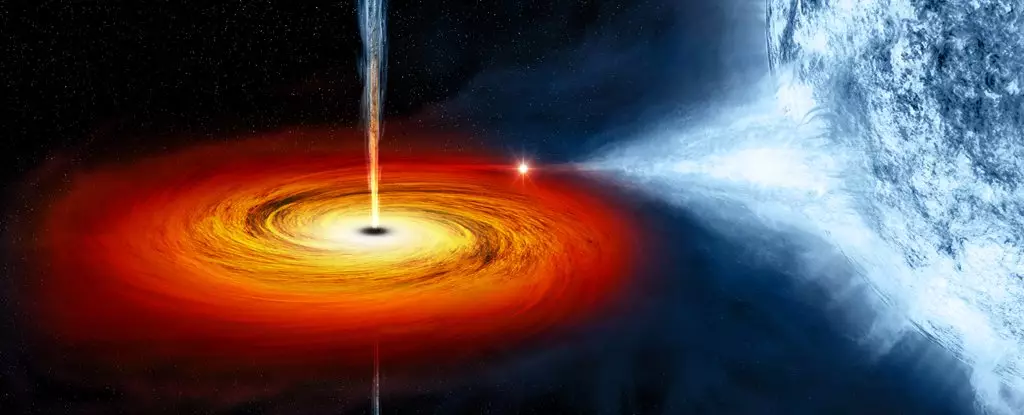For decades, astrophysicists have hypothesized that the universe’s most energetic gamma rays primarily emanate from supermassive black holes located in distant galaxies, with quasars being the iconic pits of chaos generating immense energy. However, an intriguing recent discovery has turned these long-standing assumptions on their head, linking these potent cosmic rays to a significantly closer source: V4641 Sagittarii, a microquasar situated merely 20,000 light-years from Earth in the Sagittarius constellation. This revelation opens the door to a deeper understanding of the behavior of cosmic phenomena, challenging preconceptions about the nature and origins of high-energy gamma rays.
Nestled in the vast cosmic expanse, V4641 Sagittarii features a black hole approximately six times as massive as our sun, which voraciously consumes material from a nearby giant star, weighting around three solar masses. This captivating dynamic creates an environment ripe for extraordinary radiation emission, akin to a cosmic particle accelerator. Interestingly, recent measurements have confirmed the emission of gamma rays from V4641 Sagittarii at astonishing energy levels reaching up to 200 teraelectronvolts (TeV). To put this in context, these photons carry energies trillions of times greater than visible light—an achievement once thought exclusive to more massive counterparts like quasars.
Historically, microquasars like V4641 Sagittarii have been understood to produce gamma rays at lower energy levels—typically in the range of tens of gigaelectronvolts (GeV). According to Sabrina Casanova from the Institute of Nuclear Physics Polish Academy of Sciences, the detection of such intense gamma rays from V4641 Sagittarii is both astonishing and revolutionary. This newfound capability indicates that even less massive black holes can reach energy outputs previously attributed only to their larger peers.
The pivotal role in this groundbreaking discovery was played by the High-Altitude Water Cherenkov (HAWC) observatory, situated on the slopes of the extinct Sierra Negra volcano, Mexico. Designed to capture high-energy particles, HAWC comprises 300 large steel tanks filled with purified water. When high-energy gamma rays collide with water molecules, they generate cascades of secondary particles that exceed the speed of light in that medium, resulting in a phenomenon known as Cherenkov radiation—a vivid flash of light.
HAWC’s advanced detection capabilities allow astronomers to map the sky by analyzing these flashes and determining their origins. Remarkably, with the ability to survey around 15 percent of the sky simultaneously and scan roughly two-thirds of it within a 24-hour period, HAWC has become a vital instrument for cosmic mapping. The unexpected presence of V4641 Sagittarii as a bright gamma ray source in these maps was a serendipitous surprise that catalyzed further investigation, ultimately revealing its extraordinary capabilities.
The implications of V4641 Sagittarii’s powerful emissions extend deep into our understanding of black holes and the nature of cosmic rays. Previous microquasars, such as SS 433, were known for emitting gamma rays in energies exceeding 25 TeV, but the resilience and efficiency of V4641 Sagittarii set a new benchmark. The energy outputs brought forth by this microquasar present a mesmerizing opportunity to re-examine cosmic phenomena under a new light.
One of the most intriguing aspects of V4641 Sagittarii lies in its operational dynamics, functioning on a rapid timescale—a matter of days—compared to the lifetimes of quasars, which can span millions of years. This relatively accelerated cycle allows scientists and researchers a unique window into essential cosmic processes comparable to those in blazars but at a microcosmic level. The yearnings to comprehend these processes may lead to advancements in theoretical and observational astrophysics, highlighting V4641 Sagittarii as a significant celestial laboratory for scientists across disciplines.
As we continue to peer into the cosmos, the tale of V4641 Sagittarii stands as a potent reminder of our ever-evolving understanding of the universe. This microquasar serves as a fascinating case study demonstrating that the cosmos still has a myriad of mysteries to unveil, challenging our previous notions of energy production in black holes. The discoveries being made not only elucidate the behavior of our universe but also inspire a new generation of researchers to explore further the complex and dynamic dance of celestial phenomena that define our cosmic reality.


Leave a Reply